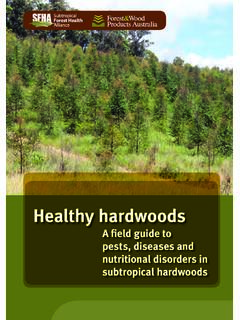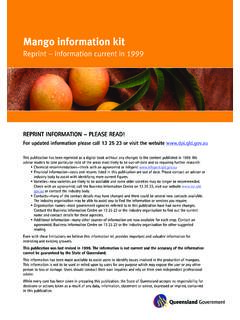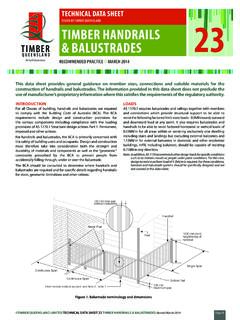Transcription of Hoop pine - Araucaria (plantations)
1 Hoop pine - Araucaria (plantations) Species name: Araucaria cunninghamii. Other names: Queensland pine, colonial pine, Aboriginal names: cumburtu, coonam. Trade name: Araucaria Mature hoop pine plantation (age 50 years) Hoop pine seedlings Wood grain of mature hoop pine Key attributes Hoop pine is a native species and a well-established commercial plantation tree in Queensland that produces a premium grade, quality tropical softwood. It is valued for uniform, knot-free timber with exceptional quality, and used for many commercially important wood products. Hoop pine has a well-established market and is in demand both nationally and internationally.
2 High-grade sawn hoop pine serves the upper end of the domestic market, taking advantage of long lengths of clear wood, and exports include sawn wood and woodchip. The potential for hoop pine plantations in Queensland Hoop pine plantations date from 1917 in Queensland and currently, about 44,000 hectares produce sawlogs, plywood and other products. Larger plantings are in the southeastern region, near Brisbane, Gympie, Maryborough, Murgon and Monto. There are some smaller plantings in north Queensland, mostly on the Atherton Tablelands. There are plantations in Papua New Guinea and in a small area of New South Wales. The Queensland plantation resource represents 95% of global hoop pine production.
3 Rotation length is generally 40 years or longer. Queensland s harvest for hoop pine sawlog in 2004 5 was more than 400,000 cubic metres (m3). When matched to appropriate sites hoop pine shows good growth rates and productivity, and is relatively tolerant of pests and diseases. Hoop pine is also very suitable for agroforestry plantings, integrating commercial timber growing into the farm with benefits such as animal shelter and land protection. Growing hoop pine Rainfall Better growth: sites receiving an annual average rainfall of >800 mm for 7 out of 10 years. Potential productivity Productivity depends on site quality and stocking rates, and can be 15 20 m3 per hectare per year on better sites.
4 The genetic quality of the seedlings also influences potential productivity. Soils It grows best on deep, well-drained, alluvial soils and volcanic soils. It can grow on a range of soil types as long as the topsoil is reasonably deep and free draining. It is slow to establish in soils low in available nitrogen. Site conditions Soil fertility: Grows over a wide range of soil fertility conditions. Shade: When young, it tolerates shade, but usually grows best in good light conditions. Dry sites: Relatively drought tolerant. A deep taproot and extensive lateral roots provide good access to water in the lower soil profile. Drainage: Prefers well-drained soils and does not tolerate waterlogging.
5 Although it can grow on heavy soils, good drainage is essential, at least in the top 45 cm. Salinity: Tolerates low to medium salinity. Frost: It can tolerate only an occasional, mild frost. Planting on slopes reduces frost damage and so may planting in mounds. Fire: It is very sensitive to fire. A good network of external and internal firebreaks will help to protect plantations. Cyclone prone areas: Moderately resilient to cyclonic winds, especially when planted away from the coast. State of Queensland, Department of Agriculture, Fisheries and Forestry, 2013. 2 Pests and diseases Stems: Attacks by the pine bark weevil (Aesiotes notablils) are usually associated with pruning damage.
6 Pruning in winter when the weevil is relatively inactive reduces the incidence of damage. The hoop pine borer (Pachycotes australis) is usually associated with logging debris and slash, but can infect and damage stands of hoop pine. The hoop pine stitch beetle (Hyleops glabratus) may cause damage to needles. Diseases: The root disease fungus Phellinus noxius is potentially a problem in young, second rotation plantations. Post-harvest, the sapwood is susceptible to blue stain. Tree improvement Hoop pine tree improvement is very advanced and intensive selection over 50 years has produced improved seed for establishing very productive, commercial plantations.
7 Important trials from the 1960s and 1970s identified the best performing provenances for growth rates, crown form and morphology and site capture that now form the basis for Queensland s tree improvement program. Seedling availability Hoop pine seedlings are usually available from community and Landcare nurseries. Wood Hoop pine wood is suitable for many appearance grade products and in general construction. The wood is taint-free and odourless, so it is suitable for food-safe products and baby cots. Potential products and applications for plantation hoop pine Hoop pine is potentially suitable for a number of product types: Solid sawn wood: Full-rotation timber is potentially suitable for general sawn and appearance products in protected environments.
8 High-grade sawn wood products include joinery, furniture and clear mouldings. Shorter lengths are used for finger- jointed furniture. Lower grade wood is marketed as structural material and treated wood is used, for example, for fencing. Untreated, lower grade wood is suitable for bins and pallets. Speciality uses include colonial-style architecture such as French doors, balustrades and decorative finishes. Veneers and engineered wood: Full-rotation timber is potentially suitable for plywood and particleboard. New composite materials with end and edge glue docking material are being developed. Wood properties Hoop pine wood is valued for its uniform density and texture, which contributes to a very fine grain that is excellent for working, painting and staining.
9 The absence of resin and odour makes it taint-free and suitable for food industry uses. The lack of resin also improves its gluing properties and grade recovery. It is very suitable for protected applications that require uniform stability and clear (defect-free) wood. State of Queensland, Department of Agriculture, Fisheries and Forestry, 2013. 3 Hoop pine plantation in south-eastern Queensland Hoop pine furniture Laser cut hoop pine wood Wood properties Plantation-grown (full rotation age) Air dry density (kg m3) 560 Density is very uniformly distributed, radially, in contrast to Pinus timbers Heartwood proportion In mature plantations, sapwood makes up more than 50% of the stem radius.
10 Immature plantation stems are usually entirely sapwood. Janka hardness (kN) , seasoned (soft) Unit shrinkage (% dimensional change per 1% moisture content change) low - radial - tangential Stiffness (GPa) 13 Estimated carbon content (kg m3) 231 Peeling recovery Rotary peeling produces veneers of all grades. Natural durability Above-ground durability: low: Class 4 life expectancy less than 7 years. In-ground durability: low: Class 4 life expectancy less than 5 years. Wood pests Lyctine susceptibility: Sapwood is not susceptible to lyctine borer attack. Termite resistance: Not resistant to termite attack. Others: Wood is susceptible to the Queensland pine beetle (Calymmaderus indicus).









